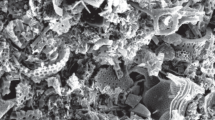Abstract
Low-melting sulphate glasses and glass-ceramics, which are effective fire and smoke retarder additives for poly(vinyl chloride) (PVC), have been developed. They are based on low-melting, glass-forming compositions in the K2SO4-Na2SO4-ZnSO4 ternary system. The preferred ternary sulphate glass melts at 420° C and has the composition K2SO4 · Na2SO4 · 2ZnSO4, which also corresponds to the composition of a congruently melting ternary compound. In a simple, tin-stabilized PVC compound, 10 phr (parts per hundred of resin) resulted in a 54% reduction in smoke in the flaming mode of the NBS Smoke Chamber. 40 phr gave a smoke reduction of 83%. The preferred ternary sulphate glass also works in concert with low levels of other known smoke retarders. For example, 10 phr of the ternary glass and 5 phr of MoO3 gave a smoke reduction of 78%, while 40 phr of the glass and 5 phr of MoO3 gave a smoke reduction of 93%. The addition of transition metal sulphates to low-melting compositions in the K2SO4- Na2SO4-ZnSO4 system led to the development of low-melting glasses and glass-ceramics containing Ni2+, Cu2+ and VO2+. These transition metal modified sulphates were also very effective smoke retarders in the simple PVC compound. All of the low-melting sulphate glasses and glass-ceramics promoted intumescence and char formation during combustion of the simple PVC compound. In this way they effectively formed thermal barriers to retard further combustion.
Similar content being viewed by others
References
W. J. Kroenke,J. Appl. Polym. Sci. 26 (1981) 1167.
R. P. Lattimer andW. J. Kroenke,ibid. 26 (1981) 1191.
Idem,, in “Analytical Pyrolysis” edited by K. J. Voorhees (Butterworths, Woburn, Massachusetts, 1983) p. 453.
R. M. Lum,J. Appl. Polym. Sci. 23 (1979) 1247.
W. H. Starnes, Jr andD. Edelson,Macromolecules 12 (1979) 797.
D. Edelson, V. J. Kuck, R. M. Lum, E. Scalco, W. H. Starnes, Jr andS. Kaufman,Combust. Flame 38 (1980) 271.
W. H. Starnes, Jr, L. D. Wescott, Jr, W. D. Reents, Jr, R. E. Cais, G. M. Villacorta, I. M. Plitz andL. J. Anthony,Org. Coatings Plast. Chem. 46 (1982) 556.
R. P. Lattimer, W. J. Kroenke andR. G. Getts,J. Appl. Polym. Sci. 29 (1984) 3783.
C. Austen Angell,J. Amer. Ceram. Soc. 48 (1965) 540.
R. E. Myers, E. D. Dickens, Jr, E. Licursi andR. E. Evans,J. Fire Sci. 3 (1986) in press.
N. V. Khakhlova andN. S. Dombrovskaya,Zhur. Neorg. Khim. 4 (1959) 924.
Author information
Authors and Affiliations
Rights and permissions
About this article
Cite this article
Kroenke, W.J. Low-melting sulphate glasses and glass-ceramics, and their utility as fire and smoke retarder additives for poly(vinyl chloride). J Mater Sci 21, 1123–1133 (1986). https://doi.org/10.1007/BF00553241
Received:
Accepted:
Issue Date:
DOI: https://doi.org/10.1007/BF00553241




